Which marketing channel has the most users in the world today? Is it social media, PPC, email, search engines or other channels? If you guessed email, then you’re right! Even in 2019, there are over 3.7 billion email users across the globe. That’s over twice the number of Facebook and Twitter users combined. For a channel that has been around since the dawn of the internet, it’s pretty impressive to see how widespread the use of email has become.
That’s why even in today’s digital landscape, businesses are still relying heavily on email to sell and to interact with their audiences. We could say that email marketing is one of the most effective marketing channels. According to OptinMonster, not only do emails have better engagement than social media (top 3 social networks have 0.58% engagement rate while email CTR is 3.71%), email marketing ROI is 4400% – definitely not something that should be overlooked.
The Email Marketing Challenges
With over 240 BILLION emails sent per day, getting the attention in full inbox is definitely a challenge. if your emails get read, marketers still have to worry about the response rate. Data from Hubspot also suggests the ideal length of an email should stay within 50 to 125 words to ensure a 50% response rate.
But at the same time, we do find some marketers who swear by long-form emails. They find that packing valuable content in emails that span multiple pages gets them even better response than short and concise ones.
Which brings us back to today’s topic – How long should your emails be? Let’s find out.
Short Email Copy – Keeping things Simple
Short emails are all about keeping your message snappy and short, usually within a single page that is above the fold. There are usually only two key parts in short emails – a brief description of the content and a call to action.
Pros:
- Generate Curiosity. The key benefit of keeping your email short (in 125 words or less) is that it helps you to keep your readers curious. In marketing, being able to generate curiosity is like having a strong fishing net that you use to pull your prospects in.
If you give out too many details in a long email, your subscribers have nothing to anticipate and will switch off once they figure out what you are all about.
On the other hand, if you tease them by releasing limited amounts of details, they will be much more motivated to stay tuned for your next email.
- Easy to digest. When emails are short and straightforward, the subscribers do not need to spend too much time trying to figure out the content of the email.
Modern web users do not have the time nor attention to read every single word online. Instead, they follow what is called the ‘F-Pattern’ scanning to consume content.
By writing your emails in short and easy-to-follow chunks, you facilitate the ‘F-Pattern’ scanning for your readers, which helps drive them to read through the entire email and follow through the conversion process.
Cons:
- May not be as impactful. This is where it starts to get tricky. When you’re writing short emails, you need to ensure that they are highly impactful and attention-grabbing for the prospects. That is because there are too many distractions online for the average internet user. There are highly engaging videos, social media posts automated through various social media management tools and many other types of content that your text email has to compete attention for.
Too long, the recipient becomes bored and moves on to something else. Too short, it becomes too hard for them to understand what you’re trying to say. It’s a delicate balance that email marketers have to strike.
While you can use visual elements, designs or images to help enhance your emails, be careful with sizes of the images you choose. It’s recommended to keep images in newsletters under 1MB and 640px width.
All of this means when you craft your email, you will need to choose your words carefully and maximize the impact of every single word, without becoming too long-winded.
- Difficult to build trust. Short emails are also not as useful in building trust with your fans since there are limits to the way you can create meaningful discussions.
How to use short emails?
The general rule of thumb is this – When in doubt, always keep your emails short. Statistically, short emails tend to perform better when they are 200 words or less.
Short emails work the best when the key objective is to simply inform the audience of an upcoming event, new promotion, product update, or change in terms. Let’s take a look at some good examples of using short emails.
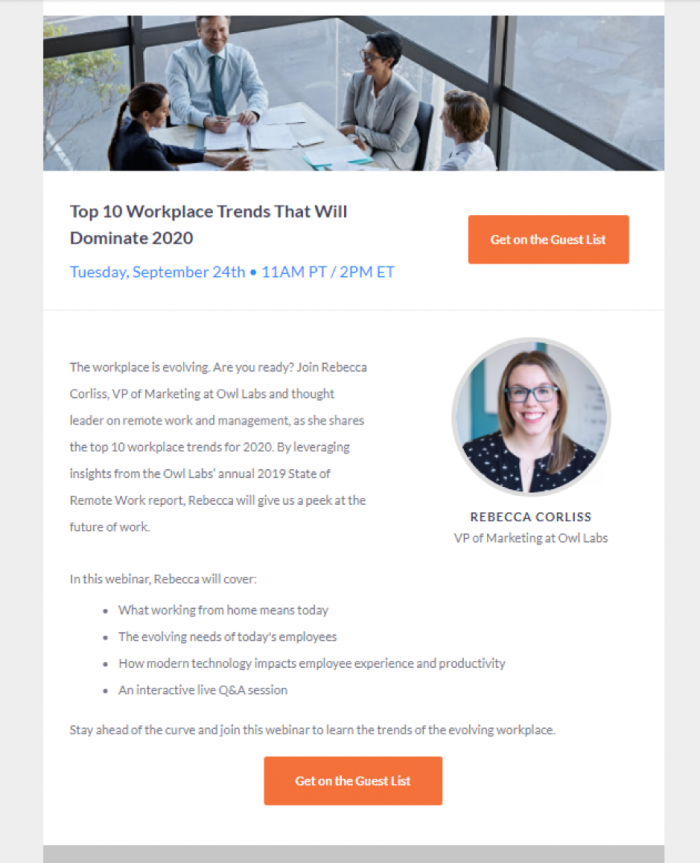
This email from Owl Labs makes excellent use of the short email format. It uses a photo of the sender to create familiarity with the audience.
The generous use of bullet points helps greatly in allowing audiences to quickly scan through the email and grab all the details he or she needs from the email.
You can also use short emails as a teaser to encourage your audiences to visit the main content, like this email from Spotify.
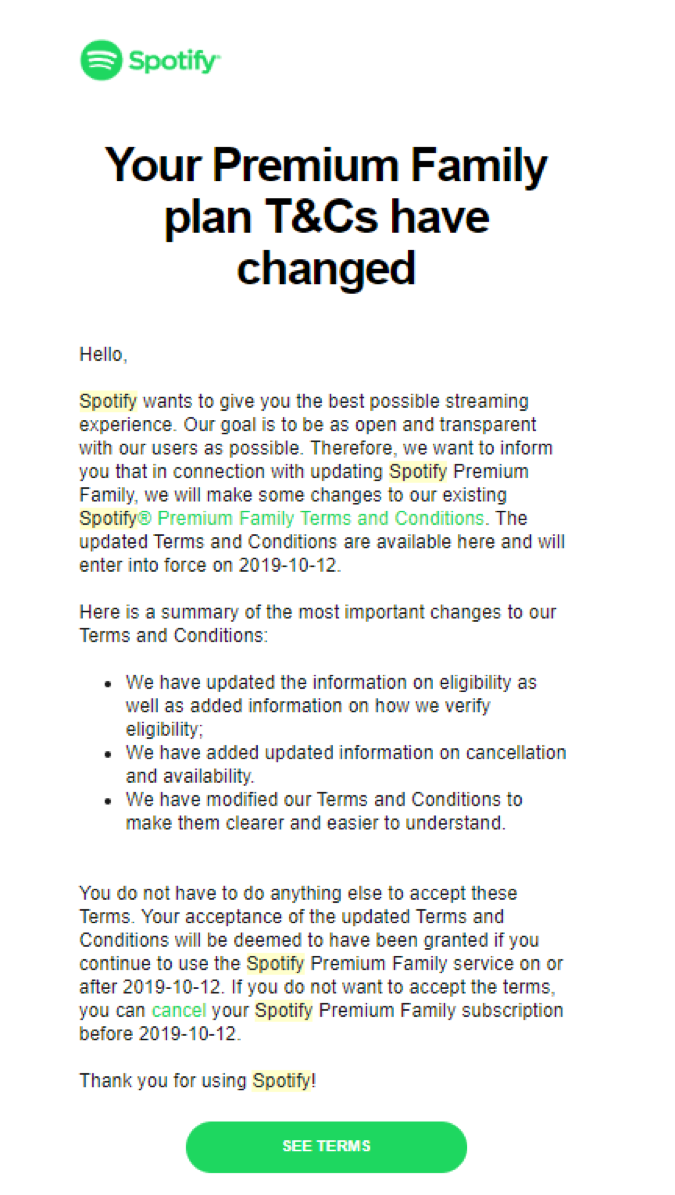
The signature green of the Spotify logo is used generously throughout the email, such as in the URL links and call-to-action buttons lets audiences quickly zoom in to all the key information (in this case, read the new Terms and Conditions).
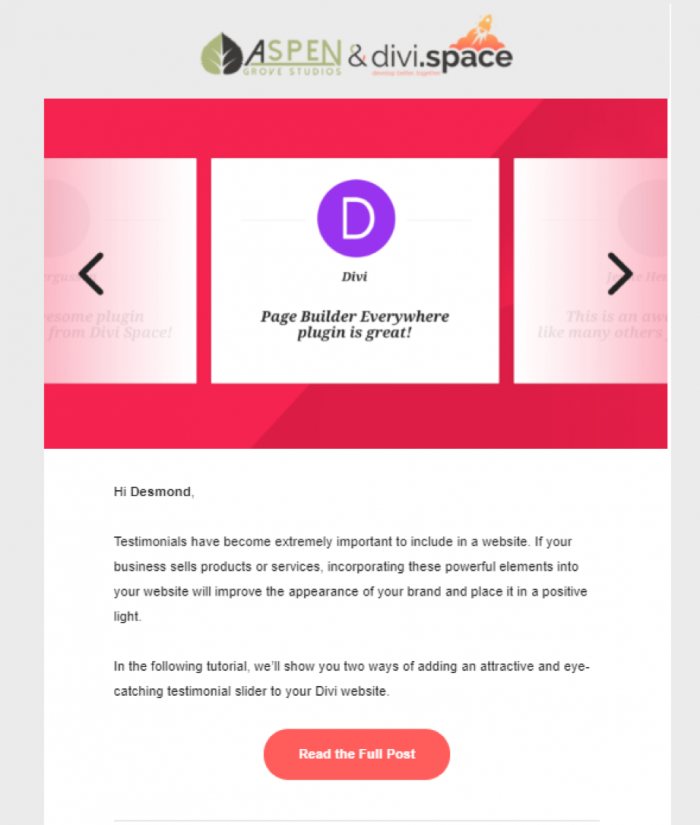
This short email from Divi gets attention without long chunks of text, thanks to its eye-catching graphics and brand logo splashed at the top of the email.
Long Email Copy – Telling stories and connecting to audiences
A long email is essentially an email that spans several pages long. It can be a sales email explaining a service or product in detail, introduction email for new subscribers with all the important info, or a snippet from the latest blog post.
Long emails sound intimidating for audiences at first. But good marketers know how to make judicial use of subheads, bold text, bullet points, and numbered lists to make long emails a joy to read, and more importantly get a great response rate.
Pros
- Personalized way of speaking to audiences. There is a reason why email is still one of the most powerful marketing mediums today. It’s not just because billions of people use it – it’s because it’s a personal way to communicate.
When marketers understand how impactful emails can be, they can use email as a channel to speak to their audiences on a personal level and create a tightly woven relationship with the audience. When you write a long email, you have much more creative freedom to use storytelling techniques to build your brand’s story and to keep audiences hooked.
- Warm-up prospects for the sales funnel. The other key advantage of long emails is that they help you to build trust with your audience. Some of the best long-form emails offer helpful advice, useful tips, and even entertaining stories that leave a lasting impression on the audience.
Once a positive impression is reinforced into the audience’s minds, they will stop perceiving marketing emails as a form of selling.
Instead, they will see it as a source of knowledge and entertainment. The best emails are able to masterfully juggle both entertainment and knowledge (much like an infomercial) to sell their offer.
How to use long-form emails
Long-form emails make the most sense for your business when you have a brand new product or service. As a new type of offer, you do not have much precedence to fall back on; hence you need to write a long email copy to explain your product or service in an educational manner, and how it adds value to the audience.
If your offer is on the higher end of the price spectrum, you should use long-form emails to explain the benefits of your product. Audiences seek as much info as possible before deciding to buy, especially if it’s an expensive purchase.
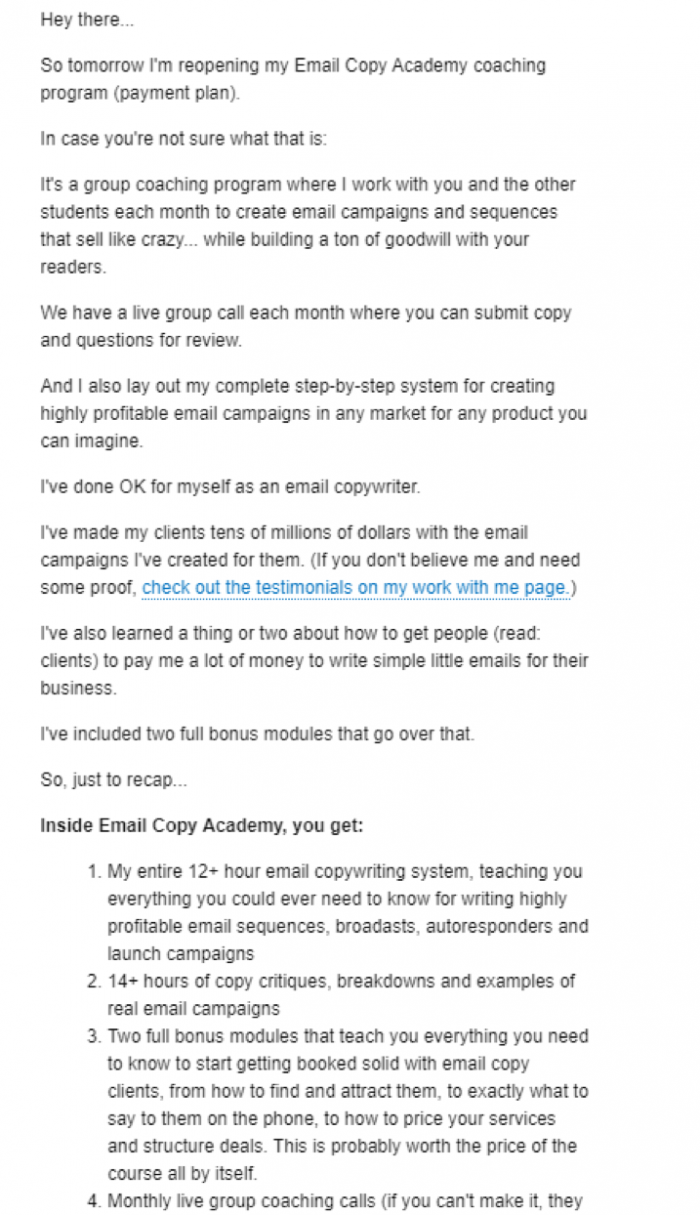
In this example, the marketer is selling a $995 training program. In order to help audiences arrive at their purchasing decision, he lists all the unique selling points of his program in his 1200 word email.
Long-form emails are also an excellent tool for nurturing leads. Savvy marketers can choose long-form emails to build up the brand’s story using the ‘infomercial’ style of entertainment and information distribution.
Choosing between long and short email copy in drip email marketing
Now that you have a clearer picture of the strengths and weaknesses of both long and short emails, here are a few more quick tips that can help you craft your email content.
Keep the audience and expectations in mind
The golden rule of marketing is always to ‘know your audience’. And this is no exception when it comes to email marketing.
The objective of your email determines the appropriate length of your email. Should you dive into details and write a 1200 words long email, or drop some breadcrumbs and entice the reader to visit your blog?
The profile of your audience will determine the best email timing to start blasting your emails. If your readers are mostly active during the weekdays and office hours, you shouldn’t be sending your emails out at 2 AM in the morning on the weekend.
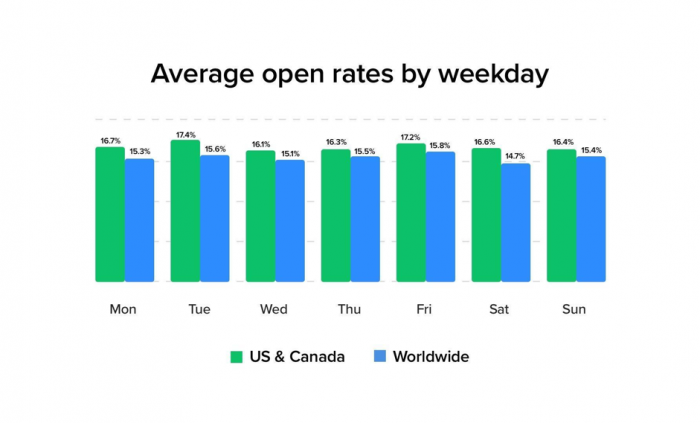
Only when you understand your subscribers and know what they seek, then you can create the type of emails that get read and responded to.
If your readers are seeking entertaining anecdotes then you could write about interesting stuff that is happening around you and your business. If they are looking for helpful advice on the latest trends in the stock market world or something more specific such as how to trade penny stocks, then you should offer sound advice and helpful analysis to keep them hooked to your emails.
Conversational writing style
Regardless of whether you’re writing short or long emails, the ability to write in a conversational tone is much more important than writing in blogs or articles.
Keep your sentences short and write in short paragraphs. Unless you have to communicate something very official or your audience specifically demands a more formal style of writing, try to avoid using big or ambiguous words in your email to keep the reading pace going. This is the key to writing powerful long emails.
Short, easy to understand sentences in small paragraphs help to make your emails easier to read and let your readers pick up important content of your email without having to read every single word.
Test long vs short copy to see what works
If you are unsure whether long or short emails resonate better with your audience, you should test out the response rate of both your long and short emails.
There really isn’t any hard and fast rule to how long your emails must be. That’s because every audience responds differently, and your marketing audience is no exception.
Sometimes, a mix of both long and short emails in a drip campaign allows you to experience the best of both worlds. For example, use short emails in your daily or weekly nurturing campaigns, then send out long emails before your product launch to drive hype.
Final tips
Crafting short yet powerful emails is an art itself. With a finite word limit, you may want to use visual images and graphics to create interactive emails and get your message across.
Your email should be short enough to be impactful, but long enough to show you actually know what you’re talking about.
The length and style of your email copy should cater to your customers’ tastes or product offer. At the end of the day, it really boils down to the readers you are writing for.
Do not take your reader’s time and attention for granted. Say what you need to in your email and don’t overstay your welcome.
At the end of the day, email marketing is a highly personal channel. It will do you well to treat email as such. Speak to your readers as you would speak with your friends and you’ll be pleasantly surprised by how they feel compelled to convert into loyal customers.
*** This is a guest post from Anita Sambol. Anita is content marketing strategist at Point Visible, a marketing agency providing custom outreach and link building service. ***